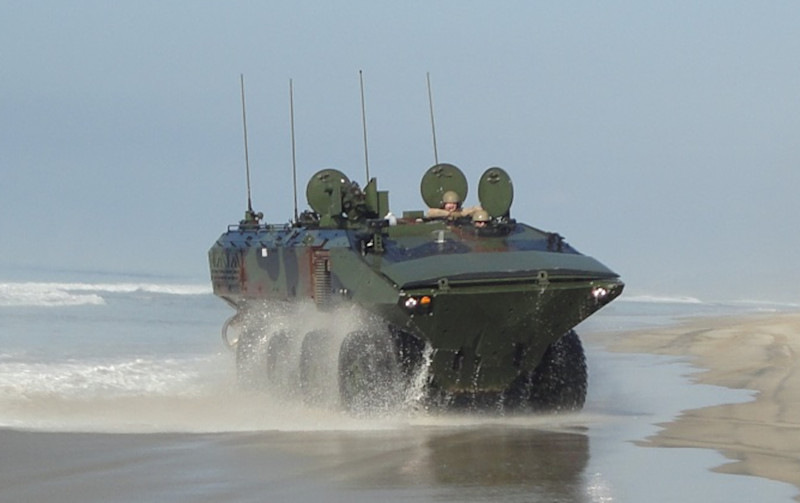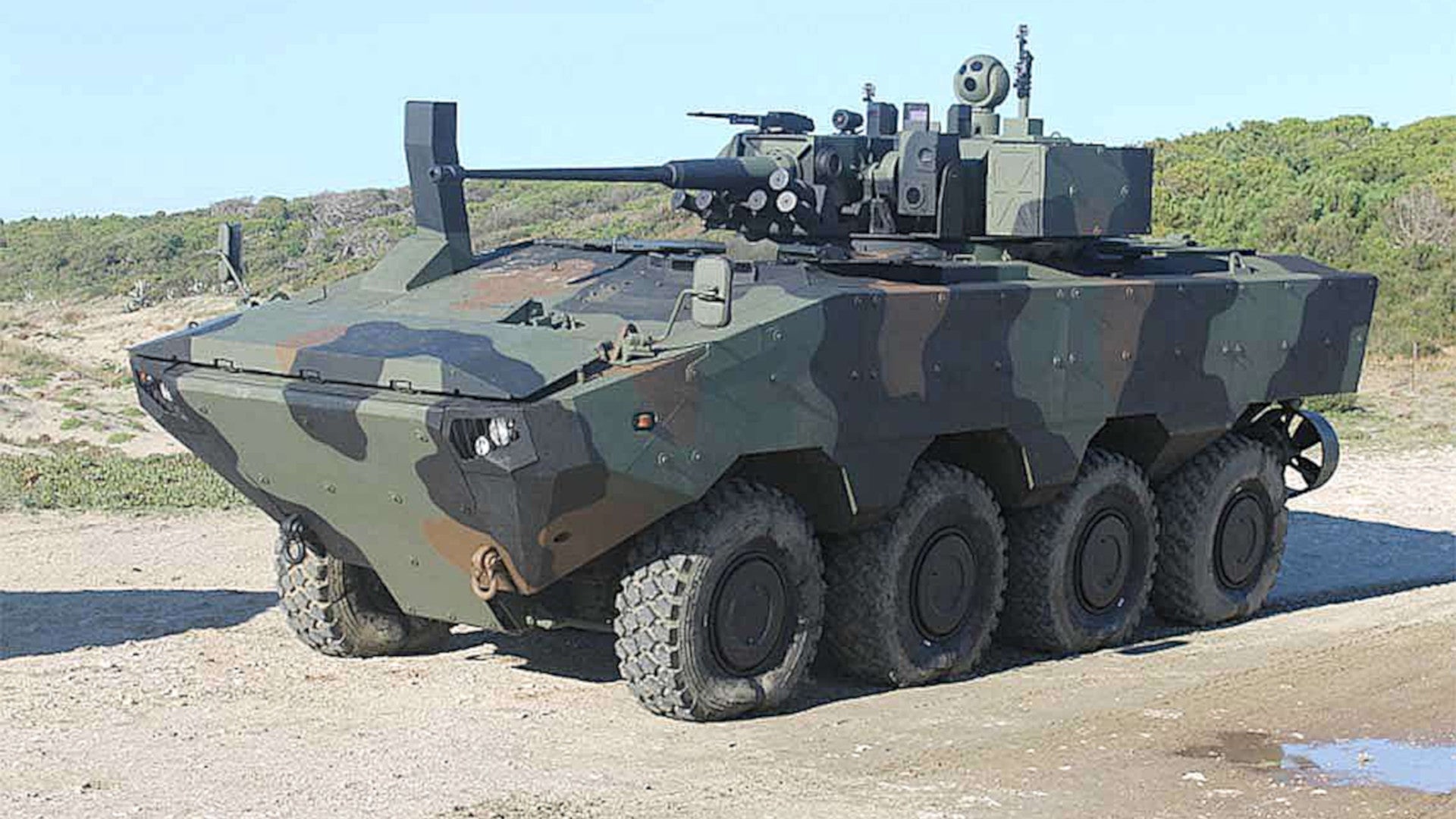The U.S. Marine Corps is following the U.S. Army’s lead and is now looking for a contractor to develop and install a turret with a 30mm cannon in a portion of its forthcoming Amphibious Combat Vehicle fleet. The move is part of a larger trend in both services to up-gun existing and future armored vehicles in light of parallel developments among potential conventional opponents, especially Russia.
Marine Corps Systems Command announced plans for the 30mm-armed variant of the Amphibious Combat Vehicle, or ACV-30, in a contracting notice on the U.S. government’s main contracting website, FedBizOpps, on Jan. 28, 2019. The Marines also want command and armored recovery versions, known as ACV-C and ACV-R respectively, as part of what the service is now calling the ACV family of vehicles.
In June 2018, the Marines revealed they had picked the SuperAV 8×8 wheeled armored vehicle as the winner of what it had called the ACV 1.1 competition. BAE Systems and Italy’s Iveco had partnered together on the proposal. Afterward, the Corps said it would look to begin a follow-on “lethality upgrade” for the vehicles, then known as ACV 1.2.

“The program office tested the vehicle to all of the ACV 1.2 transition requirements, and even subjected the vehicle to 9-foot waves without issues,” U.S. Marine Corps Colonel Kirk Mullins, the program manager for Advanced Amphibious Assault at the Marine Corps Systems Command’s Program Executive Office for Land Systems, said according to an official news story on Jan. 29, 2019. “Because of this, the Marine Corps now was [sic; has] the opportunity to combine the program into a singular ACV family of vehicles program.”
The contracting notice does not specify a particular 30mm cannon or turret for the ACV-30, but there are a number of weapon systems that could work with the SuperAV platform. Italian defense contractor Leonardo already offers its HitFist Overhead Weapons Station (OWS) for the 8×8 vehicle, which consists of an unmanned turret that can accept various 20mm or 30mm cannons. Iveco markets the SuperAV/HitFist combination as the VBA.

It also features a co-axial 7.62mm machine gun and can accommodate a two-tube anti-tank guided missile launcher on the side. It can mount various electro-optical and infrared sensors for both target engagement and general reconnaissance, as well as self-defense smoke grenade launchers.
The Cockerill 3030 turret from Belgium’s CMI Defense is another option. The Marines might be able to leverage the work CMI Defense did for the Army to integrate the turret onto a Stryker vehicle.

Unlike HitFist, the Cockerill 3030 is a significantly larger, manned turret. But this it is also modular and able to accept a wide array of weapons, which could give the Marines more armament options in the future. The experimental Army version had an XM813 30mm cannon, but the turret can accept weapons as big as a 105mm gun. The CMI Defense turret also has space for various sighting and sensor packages, as well as secondary machine guns and smoke grenade launchers.
This turret could be particularly attractive if the Marines want to add a larger automatic cannon, such as a 50mm type, to the ACV in the future. This is a general category of armored vehicle weapons that is becoming increasingly popular both in the West and elsewhere, including Russia. The Russians have been demonstrating a new 57mm turret on a number of different vehicles already, including the BMP-3 infantry fighting vehicle, the T-15 heavy infantry fighting vehicle, and the Derivatsiya-PVO, which is a fully-tracked vehicle focused on short-range air defense.

Another turret that’s ready to go that the Marines could take advantage of is the one the Army already has in service on the Stryker Dragoon variant. The primary armament, in this case, is also the XM813 30mm cannon. In 2018, General Dynamics Land Systems unveiled a further refined version of that design, as well.

Whatever they choose, the Marines will have to pick a turret that does not upset the balance of the vehicle on land and on the water. It will be important to select a design that doesn’t add undue weight to the vehicle overall and reduce its mobility, which the Marines say is a major benefit of the ACV over the service’s existing fully tracked Assault Amphibious Vehicles. This could push the service to adopt a lower profile, unmanned turret, such as the HitFist OWS.
But any of these options would be a big improvement over the ACV’s basic armament of a single .50 caliber machine gun or 40mm grenade launcher in a remote weapon station turret. This initial configuration actually represents something of a loss of firepower compared to the Marine Corps’ older AAVs. These larger vehicles have a manned turret with a single .50 caliber machine gun and a 40mm automatic grenade launcher.

It is also important to note that the Marines have no plans to up-gun all of their ACVs with the new weapon. The contracting announcement says the service is interested in buying 150 ACV-30s, as well as 39 ACV-R and 29 ACV-C vehicles.
It is not clear whether the purchase of any of these variants will be part of the Marines’ initial ACV contract with BAE and Iveco, which contains options that the service could exercise to buy more than 200 vehicles in total. The first unit to get the ACVs, the 3rd Assault Amphibian Battalion, is supposed to reach initial operational capability with the vehicles in 2020.
Recent reports say the Marines are interested in eventually buying more than 700 ACVs of all types to replace the bulk of its more than 900 AAVs. The Marine Corps’ budget request for the 2020 Fiscal Year, which is due out at the end of this month or the beginning of February 2019, is likely to have more details about the exact numbers of each variant the service is looking to buy and over what timeframe.
What is clear is that the Marine’s amphibious battalions are set to get a significant boost in firepower in the coming years.
Contact the author: jtrevithickpr@gmail.com
